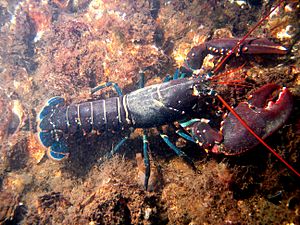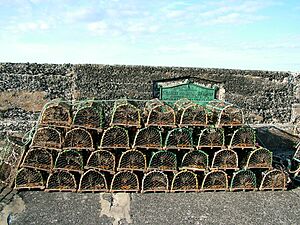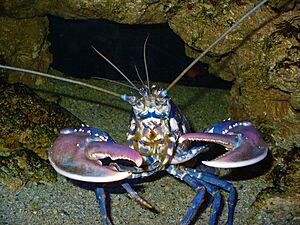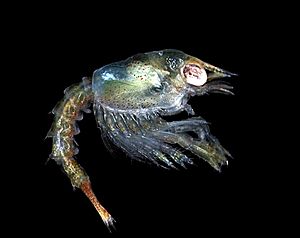Homarus gammarus facts for kids
Quick facts for kids Homarus gammarus |
|
|---|---|
 |
|
| Conservation status | |
| Scientific classification | |
| Synonyms | |
|
The Homarus gammarus, also known as the European lobster or common lobster, is a type of lobster with large claws. You can find it in the eastern Atlantic Ocean, the Mediterranean Sea, and parts of the Black Sea. This lobster is a close cousin to the American lobster.
European lobsters can grow quite big, up to 60 cm long and weigh up to 6 kg. They have two very noticeable claws. When they are alive, these lobsters are blue. They only turn bright red after they are cooked! Lobsters mate in the summer. The female carries her eggs for almost a year before they hatch into tiny, swimming larvae. European lobsters are a popular food and are often caught using special lobster pots, especially around the British Isles.
Contents
What Does a European Lobster Look Like?
The European lobster is a large crustacean. It can be up to 60 cm long and weigh 5–6 kg. However, lobsters caught by fishers are usually 23–38 cm long and weigh 0.7–2.2 kg. Like other crustaceans, lobsters have a hard outer shell called an exoskeleton. To grow, they must shed this shell in a process called ecdysis (molting). Young lobsters molt several times a year, but older ones only molt once every 1–2 years.
Lobster Claws
The first pair of legs on a lobster has two large, different-looking claws. The bigger claw is called the "crusher." It has rounded bumps and is used to crush the lobster's food. The other claw is the "cutter." It has sharp edges and is used for holding or tearing food. Usually, the left claw is the crusher, and the right is the cutter.
Why Lobsters Change Color
A live European lobster is usually blue on top with spots, and yellow underneath. The bright red color we often see only appears after the lobster is cooked. This happens because a red pigment called astaxanthin is normally hidden by a special protein in the live lobster. When you cook the lobster, the heat breaks apart this protein, releasing the red pigment.
European vs. American Lobsters
The closest relative to the European lobster is the American lobster (Homarus americanus). These two species look very similar. They can even be bred together in labs, but they don't usually meet in the wild because they live in different places.
You can tell them apart by a few things:
- The European lobster does not have spines under its nose-like part (rostrum), but the American lobster does.
- The spines on the European lobster's claws are white, while those on the American lobster's claws are red.
- The underside of the European lobster's claw is creamy white. The American lobster's claw underside is orange or red.
Life Cycle of the European Lobster
Female European lobsters are ready to have babies when their shell (carapace) is about 80–85 mm long. Males mature a bit earlier. Mating usually happens in summer. At this time, the female has just molted, so her shell is soft. The male's shell is hard.
The female lobster carries her eggs attached to her swimming legs for up to 12 months. This time depends on the water temperature. Females carrying eggs are called "berried" lobsters. You can find berried females throughout the year.
From Egg to Adult
The eggs hatch at night. The tiny larvae swim up to the water surface. They float with the ocean currents and eat tiny zooplankton. This larval stage involves three molts and lasts for 15–35 days. After the third molt, the young lobster starts to look more like an adult. It then moves to the bottom of the ocean, living a benthic lifestyle.
Young lobsters are rarely seen in the wild. They are known to dig long burrows in the seafloor. Scientists believe that only 1 out of every 20,000 larvae survives to live on the seafloor. When they reach about 15 mm in carapace length, these young lobsters leave their burrows and begin their adult lives.
Where European Lobsters Live

European lobsters live in the north-eastern Atlantic Ocean. Their range stretches from northern Norway down to the Azores and Morocco. They are not found in the Baltic Sea. You can also find them in most of the Mediterranean Sea, but not east of Crete. They are also along the south-west coast of the Black Sea. The lobsters living furthest north are found in the Norwegian fjords Tysfjorden and Nordfolda, which are inside the Arctic Circle.
Lobster Habitats
Adult European lobsters live on the continental shelf. This is the underwater land extending from a continent. They usually live at depths of 0–150 m, but typically not deeper than 50 m. They prefer hard surfaces like rocks or firm mud. They live in holes or cracks and come out at night to find food.
What European Lobsters Eat
European lobsters mostly eat other small animals that live on the seafloor. Their diet includes crabs, molluscs (like snails and clams), sea urchins, starfish, and polychaete worms.
Lobsters and Disease
European lobsters can get a disease called gaffkaemia. This disease is caused by a type of bacterium. While it's common in American lobsters, it has only been seen in European lobsters that were kept in tanks. This might be because American lobsters had been in those tanks before.
European Lobsters as Food

The European lobster is a highly prized food. It has even been mentioned in old English folk songs! It can be quite expensive and is sold fresh, frozen, canned, or even as a powder. Both the claws and the tail of the European lobster contain delicious white meat. Most of the parts inside the main body (cephalothorax) are also edible. The only parts you shouldn't eat are the stomach and the "sand vein" (which is the gut). The European lobster often costs up to three times more than the American lobster. Many people think it tastes even better.
How Lobsters Are Caught
Lobsters are mostly caught using lobster pots. These are special traps that lobsters can crawl into but can't easily get out of. Sometimes, fishers also use lines with bait like octopus or cuttlefish to tempt lobsters out of their hiding spots. Then, they can be caught with a net or by hand.
In 2008, about 4,386 tons of European lobsters were caught across Europe and North Africa. A large part of this, about 3,462 tons (79%), came from the British Isles.
Protecting Lobsters
To help protect lobster populations, there are rules about how big a lobster must be to be kept. For European lobsters, their carapace (shell) must be at least 87 mm long. Also, to protect female lobsters that are carrying eggs, fishers often put a special "v-notch" on their tail flap. If a female lobster has this notch, it is illegal to keep or sell her. This notch stays for about three molts, which protects the female and allows her to keep breeding for 3–5 years.
Scientists are also working on ways to farm European lobsters in aquaculture systems. However, this is still in early stages, and not many lobsters are produced this way yet.
History of the Name
The European lobster was first given a scientific name by Carl Linnaeus in 1758. He called it Cancer gammarus. At that time, Linnaeus used the name Cancer for all large crustaceans. Later, the lobster was placed in its own genus, Homarus. The common name "European lobster" is preferred by the Food and Agriculture Organization, but it is also widely known as the "common lobster."




